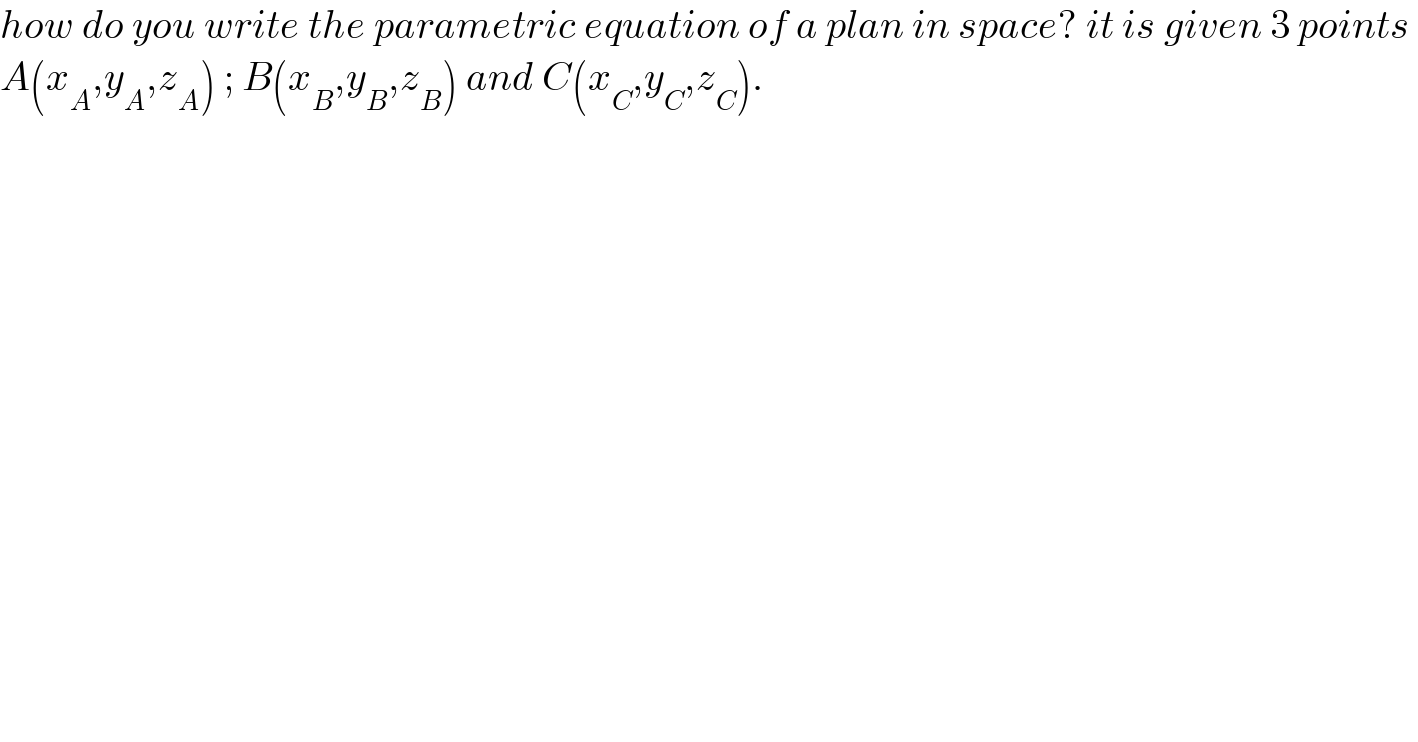
Question Number 180062 by Matica last updated on 06/Nov/22

$${how}\:{do}\:{you}\:{write}\:{the}\:{parametric}\:{equation}\:{of}\:{a}\:{plan}\:{in}\:{space}?\:{it}\:{is}\:{given}\:\mathrm{3}\:{points}\: \\ $$$${A}\left({x}_{{A}} ,{y}_{{A}} ,{z}_{{A}} \right)\:;\:{B}\left({x}_{{B}} ,{y}_{{B}} ,{z}_{{B}} \right)\:{and}\:{C}\left({x}_{{C}} ,{y}_{{C}} ,{z}_{{C}} \right). \\ $$
Answered by hmr last updated on 07/Nov/22

$$ \\ $$$$\mathrm{Finding}\:\mathrm{the}\:\mathrm{parametric}\:\mathrm{form}\:\mathrm{of}\:\mathrm{a}\:\mathrm{plane} \\ $$$$\mathrm{is}\:\mathrm{similar}\:\mathrm{to}\:\mathrm{the}\:\mathrm{parametric}\:\mathrm{form}\:\mathrm{of}\:\mathrm{a}\:\mathrm{line}. \\ $$$$ \\ $$$$\mathrm{For}\:\mathrm{line},\:\mathrm{we}\:\mathrm{need}\:\mathrm{an}\:\mathrm{initial}\:\mathrm{point} \\ $$$$\mathrm{and}\:\mathrm{a}\:\mathrm{vector};\:\mathrm{but}\:\mathrm{for}\:\mathrm{plane},\:\mathrm{an}\:\mathrm{initial} \\ $$$$\mathrm{point}\:\mathrm{and}\:\mathrm{two}\:\mathrm{vectors}\:\mathrm{are}\:\mathrm{needed}. \\ $$$$ \\ $$$$\mathrm{We}\:\mathrm{consider}\:{A}\left({x}_{{A}} ,\:{y}_{{A}} ,\:{z}_{{A}} \right)\:\mathrm{as}\:\mathrm{initial}\:\mathrm{point}. \\ $$$$\mathrm{Then}\:\mathrm{we}\:\mathrm{use}\:{B}\:\&\:{C}\:\mathrm{to}\:\mathrm{write}\:\mathrm{vectors}\:\overset{\rightarrow} {{AB}}\:\&\:\overset{\rightarrow} {{AC}}. \\ $$$$\overset{\rightarrow} {{AB}}\:=\:<{x}_{{B}} \:−\:{x}_{{A}} ,\:{y}_{{B}} \:−\:{y}_{{A}} ,\:{z}_{{B}} \:−\:{z}_{{A}} > \\ $$$$\overset{\rightarrow} {{AC}}\:=\:<{x}_{{C}} \:−\:{x}_{{A}} ,\:{y}_{{C}} \:−\:{y}_{{A}} ,\:{z}_{{C}} \:−\:{z}_{{A}} > \\ $$
Commented by hmr last updated on 07/Nov/22

Commented by hmr last updated on 07/Nov/22

Commented by hmr last updated on 07/Nov/22

$$ \\ $$$$\mathrm{Now}\:\mathrm{consider}\:\mathrm{another}\:\mathrm{point}\:\mathrm{on} \\ $$$$\mathrm{the}\:\mathrm{plane}\:\mathrm{like}\:\mathrm{D}\:=\:\left({x},\:{y},\:{z}\right). \\ $$$$ \\ $$$$\mathrm{Notice}\:\mathrm{that}\:\mathrm{the}\:\mathrm{vector}\: \\ $$$$\overset{\rightarrow} {{AD}}\:=\:<{x}\:−\:{x}_{{A}} ,\:{y}\:−\:{y}_{{A}} ,\:{z}\:−\:{z}_{{A}} > \\ $$$$\mathrm{is}\:\mathrm{a}\:\mathrm{linear}\:\mathrm{combination}\:\mathrm{of}\: \\ $$$$\mathrm{vectors}\:\overset{\rightarrow} {{AB}}\:\&\:\overset{\rightarrow} {{AC}}. \\ $$$$ \\ $$$$\mathrm{So}\:\mathrm{we}\:\mathrm{can}\:\mathrm{write}\:\mathrm{all}\:\mathrm{points} \\ $$$$\mathrm{of}\:\mathrm{the}\:\mathrm{plane}\:\mathrm{like}\:\mathrm{this}: \\ $$$$\overset{\rightarrow} {{AD}}\:=\:{t}\:\overset{\rightarrow} {{AB}}\:+\:{u}\:\overset{\rightarrow} {{AC}} \\ $$$$\rightarrow \\ $$$$<{x}−{x}_{{A}} ,\:{y}−{y}_{{A}} ,\:{z}−{z}_{{A}} >\:=\:{t}\:<{x}_{{B}} −{x}_{{A}} ,\:{y}_{{B}} −{y}_{{A}} ,\:{z}_{{B}} −{z}_{{A}} >\:+\:{u}\:<{x}_{{C}} −{x}_{{A}} ,\:{y}_{{C}} −{y}_{{A}} ,\:{z}_{{C}} −{z}_{{A}} > \\ $$$$\rightarrow \\ $$$$\begin{cases}{{x}\:=\:{x}_{{A}} \:+\:{t}\left({x}_{{B}} −{x}_{{A}} \right)\:+\:{u}\left({x}_{{C}} −{x}_{{A}} \right)}\\{{y}\:=\:{y}_{{A}\:} +\:{t}\left({y}_{{B}} −{y}_{{A}} \right)\:+\:{u}\left({y}_{{C}} −{y}_{{A}} \right)}\\{{z}\:=\:{z}_{{A}} \:+\:{t}\left({z}_{{B}} −{z}_{{A}} \right)\:+\:{u}\left({z}_{{C}} −{z}_{{A}} \right)}\end{cases} \\ $$$$ \\ $$$$\mathrm{Where}\:{t}\:\&\:{u}\:\mathrm{are}\:\mathrm{the}\:\mathrm{parameters}. \\ $$$$ \\ $$
